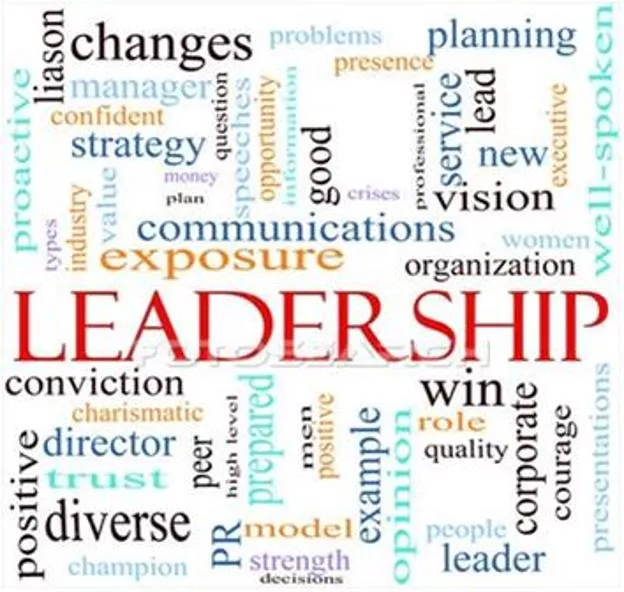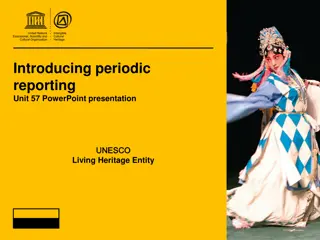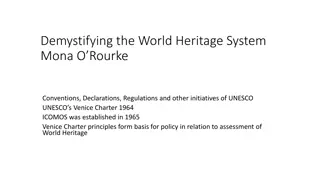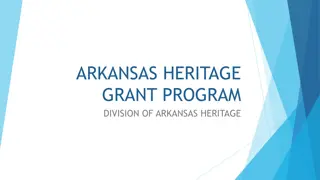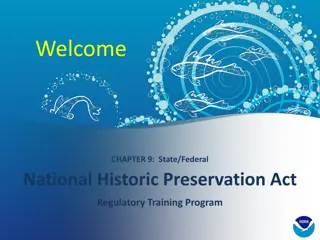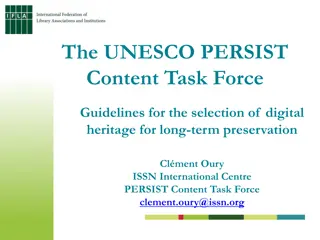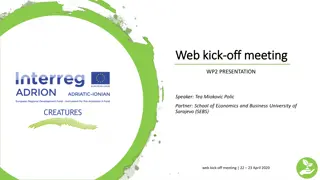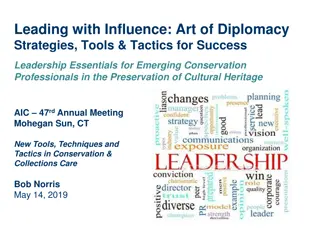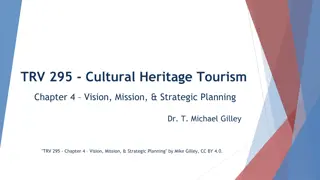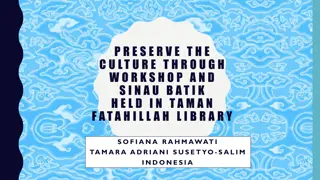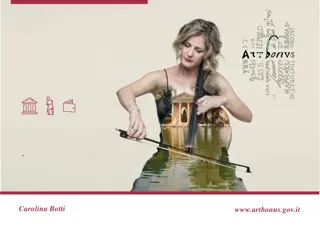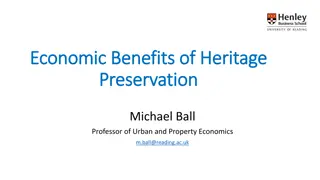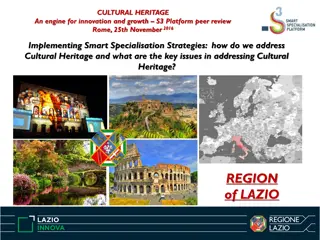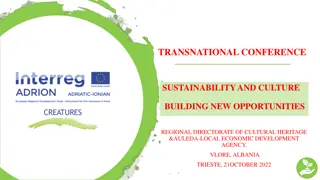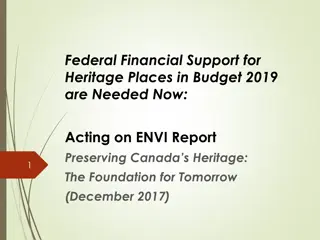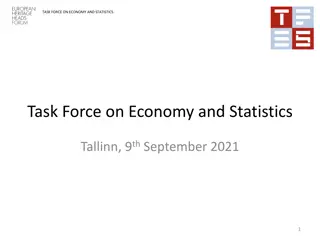Leadership Essentials for Cultural Heritage Preservation
Enhance leadership skills, serve others effectively, discover personal style, and learn key needs of followers for successful leadership in cultural heritage preservation.
Download Presentation

Please find below an Image/Link to download the presentation.
The content on the website is provided AS IS for your information and personal use only. It may not be sold, licensed, or shared on other websites without obtaining consent from the author. Download presentation by click this link. If you encounter any issues during the download, it is possible that the publisher has removed the file from their server.
E N D
Presentation Transcript
To Lead . is to Serve To Serve is to Lead Leadership Essentials for the Preservation of Cultural Heritage AIC 47rd Annual Meeting Mohegan Sun, CT Leadership Lunch Sponsors: ECPN, ANGPIC, The Getty Conservation Institute New Tools, Techniques and Tactics in Conservation & Collections Care Bob Norris May 15, 2019
To Lead . is to Serve To Serve is to Lead Learning Objectives: Enhance your ability to be an effective leader and work well with Leaders by understanding critical leadership essentials Provide Leadership techniques and tactics to help you serve others and make a difference for you, and colleagues at work and in your network Discover personal leadership style/traits that can work for you 2 2
THE INFLUENTIAL LEADER: LEADERSHIP ESSENTIALS 3
What is Leadership? "No one can whistle a symphony. It needs someone to direct it; it takes a whole orchestra to play it." . H. E. Luccock At its core, Leadership is inspiring people to follow you; providing them the opportunity to maximize their efforts; to achieve goals and objectives Motivating people Can Identify Leaders who are examples for each of these Roles Influencing people Commanding people It is situational!! Guiding people 4 4
Leaders - Be Aware of Key Needs of Your Followers Common Goals Roles: What is needed Constructive conflict resolution What Teams Need Involvement of all members Respect for differences Maintenance of Self- esteem Mutual Trust Decision- making ability 5
What Makes a Good Leader? Surveys say. Qualities that U.S. workers consider necessary for being a good Leader (in order of importance), according to a recent Yahoo! survey: 1. Communication/listening skills 2. Effective leadership skills 3. Trust in their team members to do their jobs well; Holding others accountable. 4. Flexibility and understanding 5. Coaching and working collaboratively 6. Intelligence 7. Teamwork skills 8. Even temperament 6 6
Leadership It Starts With YOU!!! Core Principles = Be / Know / Do A respected leader concentrates on three key areas: 1. Be -what he/she is, i.e. beliefs and values aligned to the team vision 2. Know - what he/she knows, i.e. job, tasks, human nature 3. Do - what he/she does, i.e. implement, motivate, and provide direction What makes a person want to follow a leader? People want to be guided by people they respectand who have a clear sense of direction/mission. To gain respect, they must be ethical. A sense of direction is achieved by conveying a dynamic vision of the future. . 7 7
Servant Leadership Model Principles of Commitment, Collaboration Care, Compassion, & Community 1 6 Conceptualization Listening Foresight Empathy 2 7 Care & Compassion 3 8 Stewardship Commitment to Grow People Capabilities Awareness 4 9 Building Community Influence 5 10
The Essence of Leadership is Service to Others On a basic level, as a leader, you exist to: - Inspire others to strive for excellence - Ensure the operating environment is safe, challenging, and fair - Teach, mentor, provide guidance True leaders put the welfare of the group ahead of their own self-interest Selfless does not mean hands-off Know your team Great leaders enhance capability of their organization by driving the actions of others to achieve greatness Leadership is all about helping others to succeed. 9 9
Collaborative Leadership: Art or Science? Supporting High supportive & Low directive Coaching High supportive & High directive Supportive Behavior Delegating Low supportive & Low directive Directing Low supportive & High directive Directive Behavior
The Blend of Art and Science: Collaborative Leadership Collaborative Leadership emphasizes and encouraging the ability to act collaboratively to solve agreed upon issues; Leaders use primarily supportive and inclusive methods to ensure that those they represent are part of the teaming process. Use directive methods selectively to ensure actions happen; Requires a new notion of power from the Leader the more power we share, the more we have to use when we need to use it. The New NORMAL is Servant Leadership I enable your success 11 11
Six Practices of Collaborative Leadership Leader Qualities/Skills that Will Help Drive Influence Understanding the context, the problem for change before you act. Assessing the Environment Defining the goals, shared values and engaging people in positive action. Creating Clarity Developing synergy of people, organizations, and communities to accomplish a shared vision. Sharing Power and Influence Understanding your own values, attitudes, and behaviors as they relate to your leadership style and its impact on others. Self-Reflection Creating safe places for developing shared purpose and action. Committing to people as a key asset through coaching and mentoring. Building Trust Developing People 12 12
Leadership Communication Communication Tips for Effective Leadership Know your Team Role Model !! Clear & Concise Problem 8 Communication: Rule of 3 1. I hear 2. I understand Communicate to Lead Problem 1 Find Your Style Face to Face !!! Problem 6 Problem 2 Problem 7 3. I know Problem 5 Problem 3 Find the WIIFM Don t Delay Problem 4 Admit Mistakes 13
The Art of Diplomacy: Influencing for success Diplomacy is the art of letting someone else have your way Daniele Vare Leadership is the art of getting someone else to do something you want done because he/she wants to do it. Dwight Eisenhower. Topics to be addressed: Power of influence: Executing the Influence Model Enhanced Influence: Managing and resolving conflict Exercise: how to influence your boss for collective success
Leading with Influence = Identifying your Power Let s review . The source of Power in any organization is: Position Relationships Personal Leaders understand the power they have and how to be comfortable using it to make a difference for others and, to achieve objectives/goals. How do you define these? What are examples? 15 15
Influence Defined Influence is The ability to change, direct, or affect the behaviors of others without ordering or threatening them. It is something you actively do to make a difference to enlist support to accomplish your goals and objectives 16 16
Influence - Core Principles The key to influence is based on a principle that underlies all human interaction, the Law of Reciprocity - people should be paid back for what they do. Influence is all about trades, exchanging somethingthe other values in return for what you want. Relationships matter! The more good ones you have the greater the odds of you finding the right individuals to trade with improves the odds you have the ability to add goodwill to increase the chance of you obtaining what you want or need. Influence requires that you know what you are doing, have reasonable plans, are competent and respected for what you do. This is the price of admission. Just about everybody is much more influential than they think they are. If you are bashful You won t be able to influence. 17 17
The Influence Model How to be a Leader without Authority Influence is the ability to change, direct, or affect the behaviors of others without ordering or threatening them. Walk in the shoes of the other person who would be an ally Identify relevant currencies: yours, theirs Assume all are potential allies Clarify your goals and priorities Influence through give and take Deal with relationships Influence is all about trades, exchanging something the other values in return for what you want Adapted from Influence Without Authority by Cohen and Bradford 18
Currencies Inventory What you might have that you can exchange Position- Related Personal- Related Inspiration-Related Recognition Visibility Reputation Insider-ness Contacts Compelling Vision Drive for Excellence High Quality Work Moral/Ethical Standards Success breeds Success Gratitude Ownership/involvement Self-concept or worth Comfort Growth Task-Related Relationship- Related New resources ($$$/people) Challenges/Learning Assistance/Help Organizational Support Rapid Response Information sharing Community sharing Being heard by others Acceptance /Friendship Inclusion Emotional support 19
Build Strong Relationships: Tips for Success 1. Seek solutions that are mutually beneficial 2. Know your colleagues, team s strengths 3. Understand the culture of how things work 4. Anticipate concerns that emanate the fear of loss 5. Recognize that influence requires developing relationships 6. Leading with influence is based on the concept that parties involved must contribute to the solution 7. Seek opportunities that identifies differences and determines ways to resolve the differences 8. Be grateful for conflicting and opposing questions and comments 9. Bridge ideas to create unity consensus technique 10. Bring facts and data to the discussion and to support your needs. 20 20
Focusing on a few key qualities and incorporating them into every action increases leadership effectiveness Research indicates these are qualities of a great leader: 1. Maintains and demonstrates strong convictions to her/his principles & core values 2. Develops and communicates a clear, winning vision 3. Builds trust through transparency, and integrity 4. Is visible: creates/promotes a high performance culture 5. Believes in service to people: coach, teach, empower, grow 6. Convinces rather than controls (influence vs. persuasion) 7. Builds commitment vs. imposes compliance 8. Continually learns What qualities of a leader fits you or you aspire to be? 21 21
Leadership Essentials LEADER CHECKLIST Actions Set direction and focus of the team Establish and sustain a positive environment Gain buy-in/alignment from all team members Encourage and ensure participation from all Coordinate Resources to match talents Communicate, Communicate, Communicate Empower with accountability Manage conflict as soon as it happens LISTEN, Provide regular feedback, adjust Celebrate success Document success and lessons learned Status 22 22
Thank You May the Force of Influence be with you and make a difference! Bob Norris rwnorris777@gmail.com 302.584.0958 23
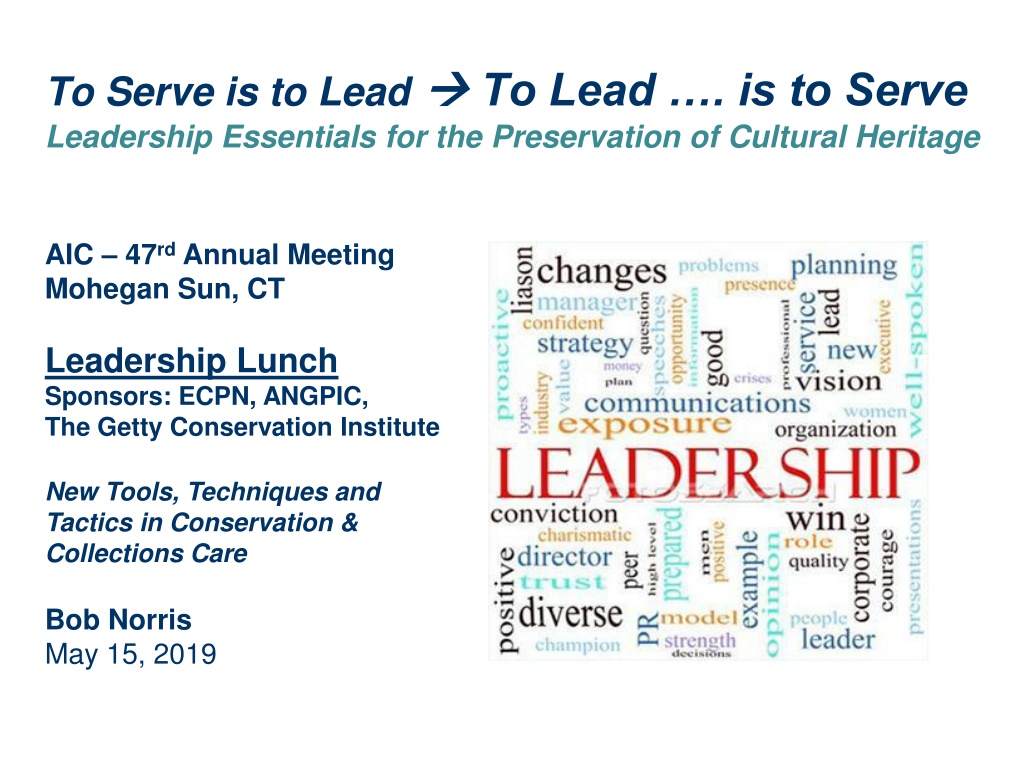
 undefined
undefined